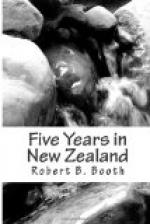Their depredations became so extensive that the Provincial Government was obliged to take steps for their extermination by letting contracts for killing them off, at, I think, sixpence per head, or rather tail, and by this means I have known a single district cleared of 8,000 to 10,000 pigs in a season.
Pig-hunting on the hills is not the inspiriting amusement it is on the plains. In the former they must be hunted on foot, and shot down, riding being impracticable, while on the plain they were hunted on horseback with dogs bred for the purpose, and the huntsman’s weapon is only a short heavy knife sharpened on both sides to a point like a dagger, and suspended in a sheath attached to the waist belt. Spears were sometimes used, but they were of a very rough and primitive description, and not effective. Pig-sticking on the modern scientific principles was not then practised in New Zealand.
For a day’s pig-hunting on the plains a party of men on strong and fast horses, with a few kangaroo dogs and a bullock dray in attendance, formed the hunting party. The location of the herd is previously noted and kept quiet. The dogs are held in leash till well within sight, say, from half to one mile off. The animals are easily startled, and they know that their best chance of safety depends on their reaching the hills before their pursuers overtake them.
With a fast horse, giving full-grown pigs a start of a mile, it will be all the huntsman can do to pick them up in a gallop of 3 to 5 miles, and the best chance in his favour is when there is a herd, and not only a single pig or small number of strong hardy fellows. Until pressed the herd will keep pretty much together, and if by good management the hunters contrive to get to leeward of them as well as to intercept them from making direct for the cover of the hills they are sure of good sport.
The kangaroo dog (so called) was a cross between a stag-hound and mastiff, very fast and powerful, and he ran only by sight. A well-trained dog on overhauling his pig will run up on the near side and seize the boar by the off lug, thereby protecting himself from being ripped by the animal’s tusks. Then the hunter should be on the spot to jump off his horse and assist the dog by plunging his knife into the beast’s heart from the off side.
With a good dog the danger to which the experienced hunter is exposed is slight. A properly trained, courageous dog will hold the largest boar for several minutes in the manner described and will not let him go till forced to from sheer exhaustion. But if he is obliged to disengage himself before assistance arrives, he will very probably be ripped or killed.
The trained bush horse will stand quietly where his rider leaves him, never attempting to move further from the spot than to nibble the grass will necessitate.
One day, having heard that a large mob of pigs had come down on the plains near the gorge of the Rakaia, some fifteen miles off, we at once organised a hunt, and two neighbours from another station promised to join us.




